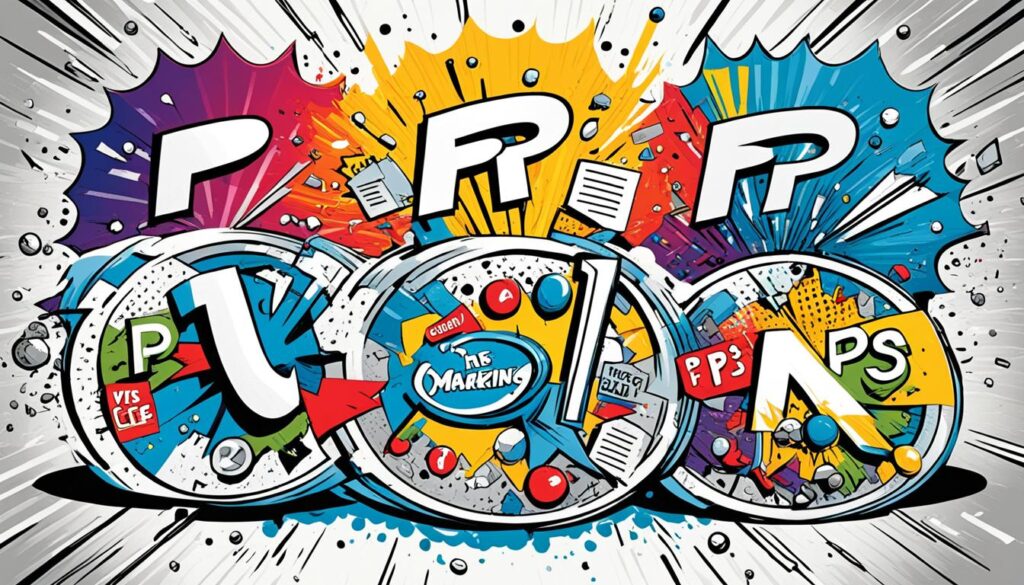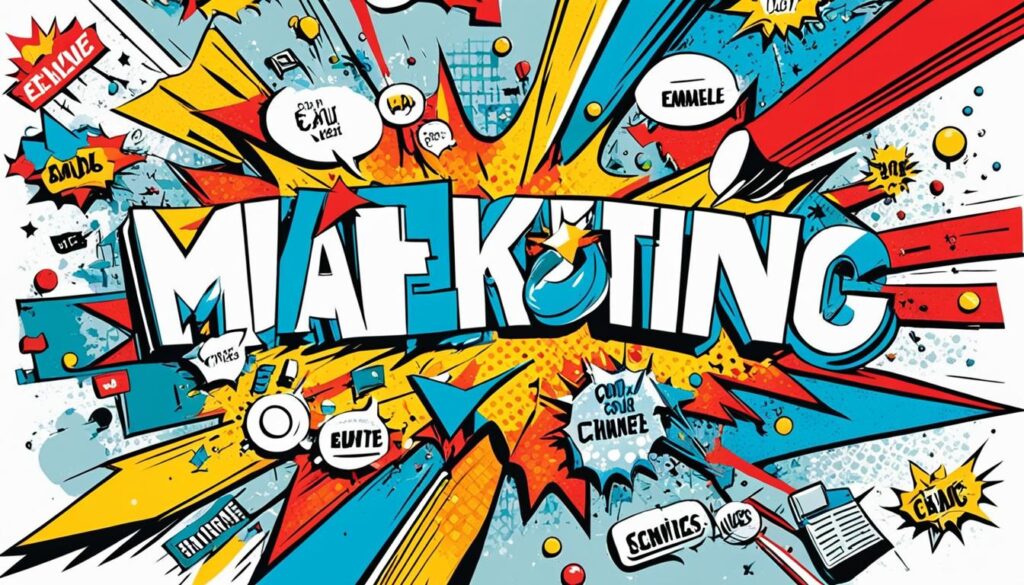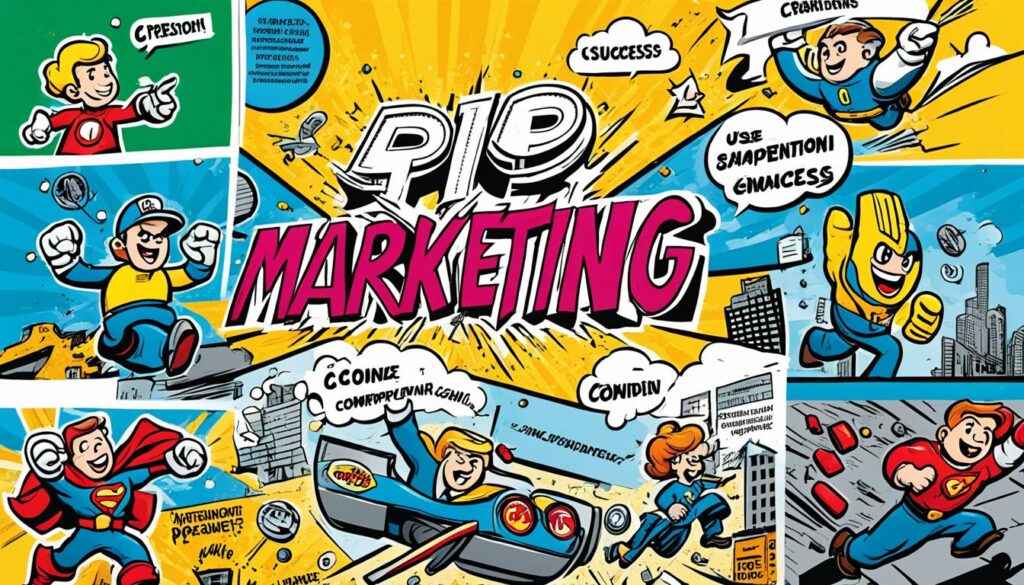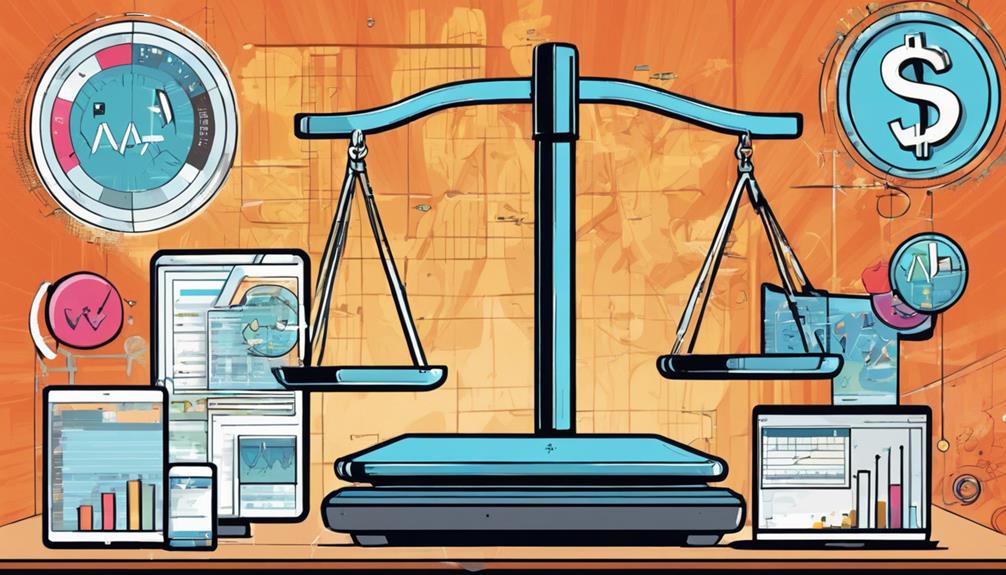Ever put everything into a product but felt it get lost among so many choices? You’re not on your own. The 5 P’s of Marketing—product, price, place, promotion, and people—are key. They are not just ideas; they are the foundation of all successful businesses. Using them correctly can boost your brand, engage your audience, and grow your business.
We’ll look at how mastering the 5 P’s leads to a strong strategy that people love. Adding these elements to your plan can make your products stand out, offer unique value, and improve your marketing results. As we explore each P, frustration turns into clarity and success.
Key Takeaways
- The 5 Ps are essential in differentiating products in competitive markets.
- Leveraging the 5 Ps helps create a unique value proposition for businesses.
- Effective marketing strategy targets appropriate audiences with suitable products.
- Understanding the marketing mix is fundamental for successful digital marketing.
- Pricing strategies significantly impact consumer behavior and purchasing decisions.
Understanding the Marketing Mix
The marketing mix is vital for creating a winning business strategy. It has grown since the 1940s. Today, it includes essential parts that boost marketing success. Managing product, price, place, promotion, and people well leads to a strong strategy that attracts your target audience.
Doing a deep market analysis lets you see the competition clearly. You can make your brand stand out by examining each part of the mix. Success stories like Canva and Warby Parker show the power of a good marketing mix. For example, Canva moved from being free to offering paid versions, showing clever market placement.
Warby Parker changed the game in selling prescription glasses by setting the price at $95. This move aimed to draw customers looking for both quality and affordability. They wanted customers to feel they got real value for their money.
Elements of the Marketing Mix:
- Product: Highlight what meets customers’ needs.
- Pick a price strategy that fits what customers can pay. Consider using discounts.
- Place: Choose accessible locations based on where and who your customers are.
- Promotion: Use advertising that speaks to your intended audience well.
- People: Good customer service and interaction keep customers happy.
By concentrating on these elements, you boost your competitive edge. The 5 Ps help make your marketing activities and plans more grounded. By using them, you can engage the market more effectively and robustly.
What are the 5 P’s of Marketing?
The 5 P’s of Marketing provide a core framework used by companies to reach their customers. This concept was created by Philip Kotler. It highlights five key areas: product, price, place, promotion, and people.
Each part serves an important role in your marketing efforts:
- Product: Looks at factors such as what it does, its quality, and its appearance. Knowing your product helps you craft your message.
- Price: Deals with its cost, discounts, and payment options. Good pricing strategies make your product appealing and motivate buys.
- Place: Is about where and how it’s sold. The right places for sale boost your chances of making a sale.
- Promotion: Uses different ways and messages to advertise. The best promotion methods get people interested and talking about your product.
- People: Focuses on staff and how they interact with customers. Great interactions set your brand apart and keep customers coming back.
Using the 5 P’s effectively lets businesses meet what customers expect. For example, Mejuri combines all five well by selling luxury jewelry at good prices. Ahold Delhaize boosted their online sales by expanding their pickup locations. This shows putting the 5 P’s into action brings real benefits.
The 5 P’s link together, forming a strong base for companies to enhance their strategies and see clear results.

Product: The Heart of Your Marketing Strategy
Your product is the core of your marketing strategy. It decides how well you can meet what customers need and want. Knowing the basics of product development helps make things that really speak to your audience.
Key Elements of Product Development
For a product development to be successful, several elements must work together. They combine to give the customer a great experience. Here are the key pieces to think about:
- Functionality: The product must solve a problem or satisfy a need.
- Quality: Keeping quality consistent builds trust and keeps customers coming back.
- Design: A good look and feel make the product more usable and appealing.
- Branding: A strong brand makes your product recognizable and earns loyalty.
Identifying Customer Needs and Wants
Understanding what your customers need is crucial. It helps your products stand out in a busy market. Look into these areas to find out what customers want:
- Demographics: Things like age, gender, income, and where people live help you know your audience.
- Psychographics: Personal interests, values, and how people live their lives affect what they buy.
- Behavioral Patterns: How often people buy, their loyalty to brands, and how they use products give valuable clues.
Examining these areas closely lets you match your product features with what customers expect. This improves your marketing strategy overall.

| Element | Description | Impact on Marketing Strategy |
|---|---|---|
| Functionality | How well a product performs its intended purpose | Shapes customer satisfaction and loyalty |
| Quality | Differentiating factor that assures reliability and value | Enhances brand reputation |
| Design | Aesthetic and user interface aspects | Attracts customers and improves user experience |
| Brbufferanding | The identity and messaging of the product | Influences perception and customer loyalty |
Focusing on product development and making sure it meets customer needs sets a strong base for your marketing. This leads to greater success in the market.
Price: Setting the Right Price for Success
Setting the right price for your product is key to its success. It should cover production costs and what customers think it’s worth. Using psychological pricing, like $9.99 instead of $10, can make a big difference to buyers.
Psychological Impact of Pricing
Retail prices are everywhere and they aim to get noticed. Knowing how prices affect emotions can help you connect with people. It’s crucial to use strategies such as:
- Tiered pricing to offer different options.
- Bundle pricing for deals on multiple items.
- Big seasonal discounts to boost sales at certain times.
Strategies for Competitive Pricing
Looking at what competitors charge helps you make smart choices. This helps you price your products in a way that attracts buyers. Some strategies to consider include:
| Strategy | Description |
|---|---|
| Cost-plus pricing | Adds a set profit margin to the costs, but might not reflect what customers are willing to pay. |
| Price skimming | Start with high prices for new, unique products and lower them over time. |
| Penetration pricing | Begin with low prices to quickly grab market share. |
| Value-based pricing | Pricing is based on what customers believe the product is worth. |

Place: Where to Sell Your Offerings
Choosing the right places to sell is key to boosting your sales. You need to know where your customers find products or services. They might look in stores, online, or both places. By knowing where they shop, you can make your sales plans better.
A smart online marketing plan uses different e-commerce sites to get more visibility. It makes shopping smooth and easy. Your products should be easy to find on popular sites. But don’t forget about local stores where some customers like to shop face-to-face. Mixing these methods helps you reach all kinds of customers well.
When planning where to sell, think about what your customers are like and how they behave. It’s important to make your products easy to get to. For instance, grocery stores make a little profit, but food companies can make about 15% profit. Clothing stores do even better, with profits around 50%. Use this info to choose where to sell your stuff.
| Industry | Average Profit Margin |
|---|---|
| Grocery Stores | 3% |
| Food Businesses | 15% |
| Clothing Retailers | 50% |
Using both old and new ways to sell makes your marketing stronger. Remember these tips to sell more and keep your customers happy. Think about where and how your products are available.

Promotion: Getting the Word Out
Promotion is crucial for boosting brand awareness and sales. It includes various activities to reach your target audience. The right promotional strategies ensure your marketing messages hit the mark and lead to advertising success.
Choosing the Right Promotional Channels
Different channels suit different promotion needs. Today, digital advertising is top, with social media, search engines, and email leading the pack. Here are some channels to consider:
- Social Media Advertising
- Content Marketing
- Influencer Marketing
- Email Marketing
- Search Engine Optimization (SEO)
Creating Compelling Marketing Messages
Your marketing messages should show how your product or service fixes customer problems. Use engaging stories, eye-catching visuals, and strong calls-to-action. When making messages, think about these:
- Identify target audience: Know their likes and needs.
- Highlight benefits: Show how you solve their issues.
- Utilize visuals: Grab attention with great design.
- Include contact information: Make it easy for customers to reach out.

| Promotional Channel | Advantages | Challenges |
|---|---|---|
| Social Media Advertising | Wide reach, targeted ads | Can be pricey, lots of rivals |
| Email Marketing | Affordable, high returns | Spam issues, people unsubscribing |
| SEO | Free traffic, trust boost | Takes time, needs know-how |
People: The Role of Team and Customer Service
In the marketing mix, people are essential as they represent your brand. They influence how customers see and feel about your brand. It’s crucial to keep your employees engaged, as their service can make or break customer relationships.
Good team dynamics create a supportive work environment. This leads to more positive interactions with customers. With proper training in customer service, employees can really shine and leave a lasting impression on customers.

Great customer service meets the needs and expectations of clients. This includes being available, flexible, and providing quality treatment. Companies focusing on these factors often build a loyal customer base, key for success.
| Key Factors | Impact on Customer Service | Influence on Brand Experience |
|---|---|---|
| Employee Engagement | Higher motivation leads to improved service | Creates positive impressions and lasting loyalty |
| Team Dynamics | Efficient collaboration enhances service quality | Fosters a sense of reliability and trust |
| Training Programs | Equips staff with necessary skills | Ensures consistent and quality customer interactions |
| Customer Feedback | Guides service improvement efforts | Strengthens customer relationships and reputation |
Paying attention to employee engagement and team dynamics boosts customer service. By making sure your team delivers top-notch service, you create memorable experiences. This keeps customers coming back.
5 P’s of Marketing – 5 P’s of Marketing in Action
Using the 5 P’s of Marketing together makes for a powerful strategy. Each one—product, price, place, promotion, and people—works with the others to create a full marketing plan. This way, every piece supports the others, boosting the whole strategy’s power.
Integrating the 5 P’s for a Cohesive Strategy
Starting to blend the 5 P’s means looking at how they connect. For pricing, you might have subscriptions or pay-per-use, which means keeping an eye on what competitors charge. For place, you could launch in key markets first, then grow based on demand. Knowing your audience well helps shape your marketing and how you talk to your customers.
Measuring Success Through the 5 P’s Framework
Tracking how well you’re doing is key to see if your marketing works. Regular checks against your goals keep your strategy on track. Analyzing campaign results helps make each effort better than the last. Having a consistent brand and message across channels strengthens your presence. It’s important to keep learning about your audience to keep your marketing mix right.

Conclusion
Understanding the 5 P’s of Marketing is crucial for success. It gives you essential tools to create strategies that truly connect with people. The parts—Purpose, Positioning, Personality, Promise, and Perception—are key. They help build a marketing plan that boosts sales, customer ties, and loyalty to your brand.
To get your marketing right, plan well. Define your brand’s purpose and personality for clear messages everywhere. Knowing how to stand out is also vital. It makes your offers irresistible. Plus, keeping promises wins customer loyalty. Managing how people see your brand is crucial too.
In summary, mastering the 5 P’s is a powerhouse strategy for today’s complex marketing scene. It supports continuous growth. With strong marketing and great audience connections, your brand is set to thrive for a long time.









